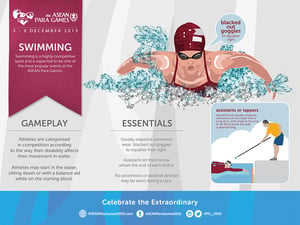What is Para Swimming
 In 1960, since the first Games in Rome, swimming was one of the eight sports practiced and is now one of the most popular sports. The number of participating athletes and countries has been increasing every four years since. Athletes are classified on their functional ability to perform each stroke, and their skills are tested in freestyle, backstroke, butterfly, breaststroke and medley events.
In 1960, since the first Games in Rome, swimming was one of the eight sports practiced and is now one of the most popular sports. The number of participating athletes and countries has been increasing every four years since. Athletes are classified on their functional ability to perform each stroke, and their skills are tested in freestyle, backstroke, butterfly, breaststroke and medley events.
Classification
The sport class names in Swimming consist of a prefix “S,” “SM,” or “SB” and a number. The prefixes stand for the strokes and the number indicates the sport classes. The lower number indicates a more severe activity limitation. The prefix “S” stands for Swimming (Freestyle, Backstroke and Butterfly), “SM” stands for Individual Medley, while “SB” stands for Breaststroke. Although athletes with different impairments compete against each other, the impact of their impairment on swim performance is similar.
|
Sport Classes S1-10: Physical Impairment
|
Sport Class S1 SB1 SM1 |
|
|
Sport Class S2 SB1 SM2 |
|
|
|
Sport Class S3 SB2 SM3 |
|
|
|
Sport Class S4 SB3 SM4 |
|
|
|
Sport Class S5 SB4 SM5 |
|
|
|
Sport Class S6 SB5 SM6 |
|
|
|
Sport Class S7 SB6 SM7 |
|
|
|
Sport Class S8 SB7 SM8 |
|
|
|
Sport Class S9 SB8 SM9 |
|
|
|
Sport Class S10 SB9 SM10 |
|
|
|
Sport Classes 11-13: Visual Impairment |
Sport Class 11 |
|
|
Sport Class 12 |
|
|
|
Sport Class 13 |
|
|
|
Sport Class 14 |
|
|
.jpg)
Photo credit: Singapore Disability Sport Council
Tournament Rules
Events are conducted as heats for eight competitors per class and the fastest eight swimmers per class compete against each other in the finals. During a swimming event, swimmers who are visually impaired are required to have an assistant to help them approach the swimming pool end wall, either to make a turn or for the finish of the race. These swimmers are also required to wear blackened goggles in all their events.
To ensure a proper start among visually impaired swimmers, the audience must maintain silence until the swimmers pass the false start rope. Any noise like horn and whistle may be misunderstood as a sign of false start.





![ActiveSG Academies and Clubs Logo (Solid Colour)[8647]](https://www.activesgcircle.gov.sg/hs-fs/hubfs/ActiveSG%20Circle%202023Theme/images/ActiveSG%20Academies%20and%20Clubs%20Logo%20(Solid%20Colour)%5B8647%5D.png?width=150&height=65&name=ActiveSG%20Academies%20and%20Clubs%20Logo%20(Solid%20Colour)%5B8647%5D.png)



-01.png?width=200&height=141&name=Team%20Singapore%20Logo%20(Red)-01.png)



